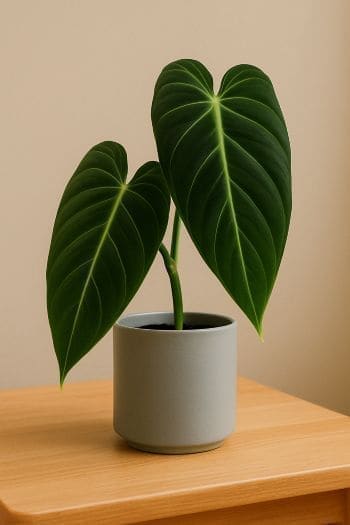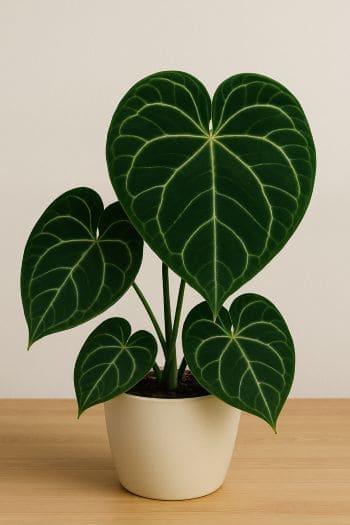Philodendron melanochrysum Care & Growing Guide
Overview
Philodendron melanochrysum, often called the Black Gold Philodendron, is a striking tropical climbing plant native to the rainforests of Colombia. It is prized for its elongated, velvety, deep green leaves with golden veins that can reach impressive lengths in the right conditions. This species thrives in warm, humid environments and is best suited for indoor growing in temperate climates, where it can be trained to climb a support for maximum leaf size and display.
In its native habitat, this philodendron grows as an epiphyte or hemiepiphyte, using tree trunks for support. Indoors, it can be cultivated in pots with a moss pole or trellis to mimic its natural growth habit.
Identification & Growth Habit
Philodendron melanochrysum is a climbing species with a vining growth pattern. Young plants produce smaller, heart-shaped leaves, while mature specimens develop elongated, velvety leaves up to 24 inches long. The leaf surface has a soft, almost suede-like texture, and the midrib and veins are often a contrasting golden or light green color.
Stems are slender and produce aerial roots at the nodes, which help the plant attach to supports. Without vertical support, the plant may trail, but leaf size will remain smaller.
Light & Placement
Provide bright, indirect light to encourage healthy growth and maintain vibrant leaf coloration. A spot near an east- or north-facing window, or a few feet back from a bright south- or west-facing window, works well. Avoid direct midday sun, which can scorch the leaves, causing brown patches.
In lower light, growth will slow and leaves may be smaller. Supplemental grow lights can be used in dim interiors.
Watering & Humidity
Water thoroughly when the top 2–3 inches of soil feel dry to the touch. Always use a pot with drainage holes to prevent waterlogging, as this plant is susceptible to root rot. Reduce watering slightly during the cooler months when growth slows.
Maintain humidity at 50% or higher. Use a humidifier, pebble tray, or group plants together to increase ambient moisture. In dry air, leaf edges may brown or curl.
Soil & Repotting
Use a well-draining, loamy potting mix that retains some moisture but does not stay soggy. A recommended blend includes peat moss or coco coir, perlite, and orchid bark. This combination provides aeration for roots and mimics the airy substrate of its natural habitat.
Repot every 1–2 years or when roots begin to circle the pot. Choose a container 1–2 inches larger in diameter than the current one to avoid excessive soil volume that can hold excess moisture.
Fertilizing
Feed monthly during the active growing season (spring through summer) with a balanced liquid fertilizer, such as a 10-10-10 NPK formula, diluted to half the recommended strength. Avoid over-fertilizing to prevent salt buildup, which can damage roots. Flush the soil with plain water every few months to remove excess salts.
Pruning & Training
Prune to remove yellowing or damaged leaves and to control length. Use clean, sharp scissors or pruners to make cuts just above a node.
For optimal growth and larger leaves, train the plant to climb a moss pole, trellis, or other vertical support. Secure stems gently with soft ties. Keep the moss pole moist to encourage aerial roots to attach and absorb moisture.
Propagation
Step-by-Step Stem Cutting Method
- Identify a healthy stem with at least one node and one leaf.
- Using sterile scissors or pruners, cut just below the node.
- Remove any leaves that would be submerged in water or buried in soil.
- Place the cutting in a jar of clean water or in moist, well-draining potting mix.
- If rooting in water, change the water every few days to prevent stagnation.
- Roots typically develop within 3–6 weeks. Once roots are 2–3 inches long, transplant into soil.
Common Problems
Pests
- Spider mites: Look for fine webbing and stippled leaves. Treat with insecticidal soap or horticultural oil.
- Mealybugs: White, cottony masses on stems and leaves. Remove manually and treat with neem oil.
- Scale insects: Brown or tan bumps on stems. Scrape off gently and apply horticultural oil.
Diseases
- Root rot: Caused by overwatering or poorly draining soil. Remove affected roots and repot in fresh mix.
- Leaf spot: Brown or black spots may indicate fungal infection. Remove affected leaves and improve air circulation.
Toxicity & Pet Safety
Philodendron melanochrysum is toxic to cats, dogs, and humans if ingested, due to calcium oxalate crystals. Keep out of reach of pets and children. Ingestion can cause oral irritation and discomfort.
Styling & Decor Tips
With its dramatic foliage, this plant makes a bold statement in living rooms, offices, or entryways. Train it up a tall moss pole for a vertical accent, or place it in a decorative floor planter to draw the eye upward. Its dark leaves pair well with light-colored walls and minimalist decor for contrast.
Varieties & Cultivars
Philodendron melanochrysum is a distinct species and not widely hybridized. However, it is sometimes confused with Philodendron gloriosum or hybrids like Philodendron ‘Splendid’ (a cross between P. melanochrysum and P. verrucosum). Be sure to verify identification when purchasing.
Buying Tips & Maturity
When buying, look for plants with firm, unblemished leaves and no signs of pests. Younger plants may have smaller, rounder leaves; as they mature and climb, leaves will elongate and develop the characteristic velvety texture and golden veins. A healthy plant with support and good care can reach several feet in height indoors.
Seasonal Care
- Spring/Summer: Active growth period. Increase watering frequency, maintain high humidity, and fertilize monthly.
- Autumn/Winter: Growth slows. Reduce watering, stop fertilizing, and ensure plant is kept away from cold drafts.
FAQ
- How fast does Philodendron melanochrysum grow?
Growth rate is moderate to fast in warm, humid conditions with bright, indirect light. - Can it grow without a moss pole?
Yes, but leaves will stay smaller and the plant may trail rather than climb. - Why are my leaves turning yellow?
Common causes include overwatering, poor drainage, or nutrient imbalance. - Can I grow it outdoors?
Only in frost-free, tropical to subtropical climates. Otherwise, grow indoors or in a greenhouse. - What’s the best humidity level?
Aim for 50% or higher for optimal leaf health and size.
Sources: Wikipedia, The Spruce






